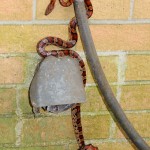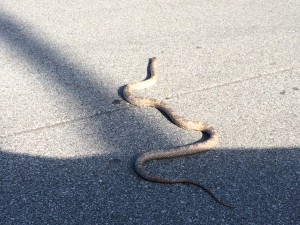
This rhyme has been around for decades suggesting that rain increases during the month of April. In recent years the amount we have received has caused local flooding, and most in Escambia County will remember receiving 26” of rain in 24 hours! These heavy localized rain events have certainly removed pollen from the air but they have also dropped blossoms from plants, dropped baby birds from their nests, forced fire ants to surface and move to high ground, and then there are the snakes.
It was actually these flooding events that developed the need for the snake program I am currently doing for Extension. Highly saturated ground forced the snakes to search for high ground. Patios, driveways, garages, and occasionally bathrooms, became popular places for the reptiles to dry off. In the last week or two I have had calls about snakes in buses, on bushes, and in the laundry room, and I actually met someone at a restaurant to identify what kind of snake they found in their home.
For many, it does not matter what kind of snake it is, they are all terrifying and dangerous and unwanted in the yard. For others, nonvenomous snakes are not welcome but they are not life threatening. Venomous snakes on the other hand… well that’s a different story. The problem here is that many do not know how to tell a moccasin from one of the water snakes. When you are not sure, you are more nervous than you may need to be. Venomous snakes truly bother people psychologically.
There are six venomous snakes in Florida and all six have been found in the panhandle. Five of these are members of the “pit viper” group and can be identified by their triangular shaped head, elliptical pupil in the eye, and a heat sensitive pit in front of their nostril. Most venomous snakes also have a dark colored “mask” (stripe) across their face. It is the mask character that I look for first, because many nonvenomous snakes flare their head when threatened and you have to get close to check the shape of their pupil. The pit vipers include the Copperhead, Moccasin, Pygmy Rattlesnake, Timber Rattlesnake, and the Eastern Diamondback. The non-pit viper is the Eastern Coral Snake. Each of these snakes should be considered dangerous and handled only by a professional if in your home. Remember, 95% of the people bitten by venomous snakes are either trying to catch or kill them.

The head of a pit viper. Notice the additional pit, elliptical pupil, and “mask” across the eye. Photo: Molly O’Connor
There are several methods you can use to reduce the chance of an encounter in your yard or home, and Extension would be glad to help with these. But remember, you live in Florida and snakes are part of the landscape here. Also remember there are four snakes in the panhandle that FWC staff are tracking: the Florida Pine Snake, Southern Hognose, Eastern Indigo, and the Eastern Diamondback. If you do encounter any of these visit http://myfwc.com/conservation/you-conserve/wildlife/snakes/ to log a report and include a photograph and GPS location if possible. If you have any questions about snake encounters contact your county Extension office.
Posted: April 26, 2015
Category: Natural Resources, Wildlife
Tags: April, Bring, May…, Panhandle Outdoors, Showers, Snakes


